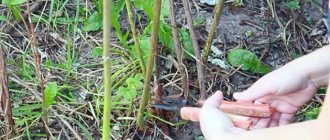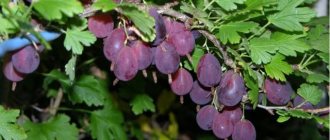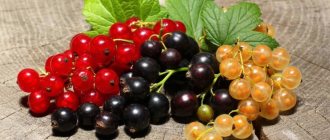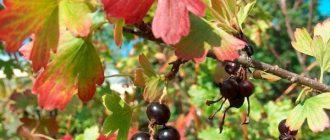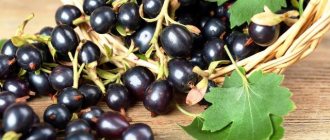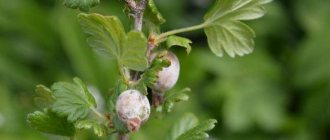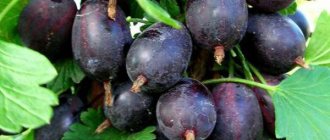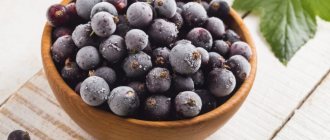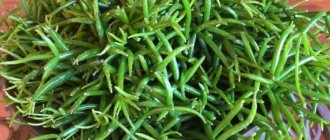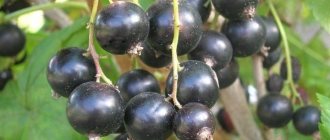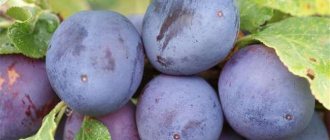Author: Natalya Category: Fruit and berry plants Published: June 29, 2015Republished: February 26, 2019Last edits: November 2, 2020
- Aphids on gooseberries
- Treatment in spring
- What to feed
The common gooseberry (lat. Ribes uva-crispa) , or rejected , or European , is a species of plant in the Gooseberry family, first described by Jean Ruel in 1536. Gooseberries are native to North Africa and Western Europe, but are now widespread throughout the world. In the wild, the common gooseberry grows on mountain slopes and in forests, being the ancestor of many cultivated varieties grown in gardens. Gooseberries, along with such berry crops as currants and raspberries, are one of the most common berry bushes in our gardens. Today there are about one and a half thousand varieties of gooseberries. Its fruits contain acids, sugars and vitamins that are beneficial to the human body, so it is consumed both raw and used to make jelly, jam, marmalade and wine. Gooseberries are also in demand in medicine.
Botanical description
Gooseberry is a low shrub - up to one hundred and twenty centimeters tall, with exfoliating bark of brown or gray color. The cylindrical shoots have thin needle-like thorns. Gooseberry leaves are petiolate, heart-ovate or round, three to five lobed, dull, pubescent with short villi, the edges of the leaf blade are blunt-toothed. Greenish or reddish flowers, single or several, grow from the axils of the leaves.
Gooseberry is the earliest of the honey-bearing berry bushes. Gooseberry berries, oval or spherical with obvious veining, 10 to 40 mm long, naked or covered with coarse bristles, ripen from June to August. If the original species has green fruits, then thanks to the work of breeders, today red gooseberries (varieties Krasnoslavyansky, Ravolt), yellow gooseberries (varieties Yellow Russian, Rodnik), white gooseberries (varieties Triumph, Belorussky Sakharny) and even black gooseberries (varieties Negus, Protector). Although varieties of the usual color for this berry still remain in demand - green gooseberries of the Malachite, Yubileiny, Ural Izumrud and many others varieties.
This article is devoted to pests and diseases of gooseberries and the fight against them, but if you follow the rules for planting and caring for gooseberries, then all these troubles can be avoided.
- Strawberries: planting and care, growing from seeds
Gooseberry varieties resistant to powdery mildew
The main prevention against spheroteca and other diseases is the selection of varieties that are resistant to this type of disease and adapted to the conditions of the region or even district.
Breeders today offer the following gooseberry varieties resistant to powdery mildew: “Cooperator”, “Orlyonok”, “Consul”, “Malachite”, “Black Negus”, “Mashenka”, “Yubileiny”, “Finnish”, “Grushenka”, etc. .
In recent years, gardeners have been in increased demand for thornless varieties that are resistant to fungal diseases: “Kolobok”, “Ural Grapes”, “Harlequin”, “Kuibyshevsky”, etc.
Gooseberry diseases and their treatment
Unfortunately, gooseberries have many enemies among insects, and gooseberries suffer from various diseases. However, if you follow all the rules for growing and caring for this crop, gooseberry diseases and pests will not have a chance to settle in your garden. But even if trouble happens and the gooseberry gets sick with something, nothing irreparable will happen if you recognize the trouble at the very beginning and take the necessary measures to save your garden, and in order to find out the problem, you need to have information about it, and we are ready for you provide it. In this chapter we will answer most of your questions about what gooseberry diseases are and how to save gooseberries from certain diseases.
White plaque
As a rule, this is a symptom of so-called powdery mildew. There are two varieties of this disease - American and European, and we will talk about each of them separately.
Plaque on gooseberries
White plaque on gooseberries is the initial stage of powdery mildew disease, brown plaque is a later stage of the same disease.
Powdery mildew
Most often, this fungal disease develops on gooseberries or currants. Powdery mildew looks like a white coating on gooseberries in the form of a cobweb. There is a difference between European powdery mildew and its American variety (spheroteka), which we will talk about later.
White berries on gooseberries are the beginning of a disease that is important not to miss. Gradually, the white, loose coating becomes a dense brown crust, the diseased shoots bend and die, the leaves turn yellow, curl, break, the berries crack and fall off while still green. The entire gooseberry crop may die, and within a few years, if treatment is neglected, all the plants may be lost.
The fight against powdery mildew on gooseberries should begin immediately after the first symptoms of its appearance are detected: if the gooseberry is covered with plaque during flowering or fruiting, spray it two to three times at intervals of a week or ten days with a solution of soda ash and soap at the rate of 5 g of soda and 50 g of grated soap per 10 liters of water. Affected berries and shoots are destroyed.
If you find powdery mildew before the buds open, act with confidence: the best remedy against powdery mildew is spraying with fungicides.
Treat the gooseberry bushes and the soil under them with Nitrophen solution or a three percent solution of iron sulfate, or a one percent solution of copper sulfate. Preparations such as Fundazol, Horus and Topaz have proven themselves well in the fight against this main enemy of gooseberries. As a preventive measure, it is recommended to dig up the soil on the site in spring and autumn. You can avoid fighting the disease by growing gooseberry varieties that are resistant to powdery mildew - Orlyonok, Consul, English Yellow, Northern Captain, Chernomor and others.
Gooseberry Spheroteka
Spheroteka is an American powdery mildew that is found in our gardens even more often than European powdery mildew. This type of powdery mildew is not much different from the European one in symptoms, and the means of combating it are approximately the same. So, what to do if the gooseberry is covered with a coating of spheroteca? It is necessary to start treating with fungicides as quickly as possible and not stop at half-hearted results, otherwise you will have to start all over again.
Treat gooseberries for spheroteca and be sure to determine the cause of the disease, that is, find out what agrotechnical errors resulted in the gooseberries' susceptibility to American powdery mildew, and eliminate them. Do not neglect preventive measures that strengthen the gooseberry’s immunity to diseases.
Spots on gooseberries
There may be several reasons for the appearance of spots. If at the end of May or early June, gray-brown or red spots with a yellow rim began to cover the leaves and berries of the gooseberry, and then the spots turned white, and only the rim around them remained brown, you are faced with white spotting, or gooseberry septoria. By August, the leaves may fall en masse, shoot growth will noticeably decrease, and next year's harvest will be in jeopardy. It must be said that septoria primarily affects weakened specimens, so be attentive to the health of your plants.
fight white spotting by treating the gooseberries and the soil around the bush with fungicides. Be sure to remove all affected leaves from the bushes and trim the shoots back to healthy tissue.
Anthracnose
Small brown spots with dark shiny tubercles on gooseberry leaves, gradually merging with each other - this is anthracnose gooseberry disease. As a result of the disease, the foliage on the gooseberry dries out and falls off, and leaf fall begins from the lower branches of the bush. The development of the disease is more intense during the rainy period in mid-summer.
- Apricot: growing in the garden, types and varieties
In early spring, before the buds open, spray the gooseberries and the soil around the bushes with nitrophen or one percent copper sulfate. Bordeaux mixture (100 g per 10 liters of water), homitin, cuprosan, colloidal sulfur are suitable for combating anthracnose. The same drugs are also used after the first manifestation of septoria on gooseberries.
Rust
Orange pads may form on the leaves, flowers and ovaries of gooseberries - this is goblet rust, which often affects the plant if sedge grows nearby. Small yellowish spots on the upper side of the leaf blade and yellow-orange growths on the underside of the leaf are symptoms of columnar rust, but it can only affect gooseberries if cedar or pine grows somewhere nearby.
An effective remedy against both rusts is triple treatment of gooseberries with a one percent solution of Bordeaux mixture or any other fungicide. The first session should be carried out when the leaves bloom, the second - when the buds appear, the third - after flowering. If the rust damage was very severe, carry out the fourth spraying ten days after the third.
Gooseberry disease
The gooseberry fruit is affected when the plant becomes infected with powdery mildew - it becomes covered with a white coating, which then becomes a brown crust, cracks and falls off the bush before it has time to ripen.
Scab on gooseberries
Actually, I’ve never heard of gooseberries getting scab. This problem usually occurs in fruit trees and potatoes. Other berries that do not suffer from scab are strawberries, wild strawberries, raspberries, blackberries, currants and blueberries. True, sometimes amateur gardeners call powdery mildew on gooseberries “scab.” But if you suspect that your gooseberry might have become infected with scab from an apple tree or from some other plant, treat the gooseberry with Bordeaux mixture, Fitosporin or copper sulfate.
Gooseberries turn yellow
Why do gooseberries turn yellow? Yellowing of the leaves is the first sign of spheroteca infection - powdery mildew. Yellow stains on the leaves also occur when gooseberries are infected with mosaic, a viral disease that, unfortunately, cannot be treated. Bushes affected by mosaic must be uprooted and burned. To prevent this disease from appearing in your garden, carefully inspect gooseberry seedlings before purchasing and under no circumstances purchase suspicious or weak specimens.
Mold on gooseberries
This is the same powdery mildew that we already wrote about.
Gooseberries are falling
Why do gooseberries fall off? Gooseberry fruits can fall due to the caterpillars of the moth, which we will talk about a little later. Gooseberries also fall off from powdery mildew.
The essence of the disease, how it manifests itself
Powdery mildew is caused by fungi that produce spores twice a year: in spring and summer. The mycelium grows throughout the bush, affecting leaves, berries, and shoots. Powdery mildew can be easily detected by noticing the following lesions:
- the formation of a whitish coating on the berries in the form of a cobweb;
- gradually the web becomes brown and resembles felt;
- the berries become cracked and fall off;
- the leaves are covered with a powdery coating, they darken and curl;
- shoots are bent;
- the bush stops growing.
If treatment is not started on time, fruiting stops and the plant dies, affected by mycelium, which covers the entire plant.
Note: To strengthen the immunity of the berry crop, it is planted in the sun, in well-windowed places and fed with phosphorus-potassium compounds.
Gooseberry pests and their control
Gooseberries also have more than enough pests, and you need to know each one by sight. We will tell you about those that are the most common cause of problems.
Aphids on gooseberries
The gooseberry shoot aphid infects leaves and young shoots of gooseberries, feeding on their juice. As a result of the vital activity of aphids, which produce several generations over the summer, the leaves curl, and the shoots slow down and eventually stop growing. It is not easy to detect aphids right away - they are very small and green in color, and you can notice them when there are already too many of them. Cut off and destroy damaged shoot tips and treat gooseberry bushes with Actellik or Karbofos.
If you managed to detect the appearance of aphids at the very beginning, it will be enough to spray the gooseberries with a solution of three hundred grams of soap in ten liters of water. And carefully examine the area: if you find an anthill on it, know that aphids will appear on the gooseberries all the time, and you need to fight first of all not with aphids, but with ants.
Caterpillars
In early spring, gooseberries that are just opening their leaves are attacked by caterpillars that emerge from eggs laid along the veins of the underside of the leaves by butterflies of the yellow or pale-legged gooseberry sawfly. One butterfly can lay up to 150 eggs, and two or three generations of sawflies develop in one season.
Treatment of gooseberries with insecticides (Actellik, Karbofos, etc.) against the first generation of caterpillars is carried out from the moment the buds open until the formation of buds, the next time you need to spray the gooseberries immediately after flowering, and if after picking the berries you again find caterpillars on the gooseberries, carry out a third treatment of the bushes insecticides. Try to change insect killers every year.
The caterpillars of the gooseberry moth, which reach a length of four centimeters, behave in approximately the same way. They are destroyed by the same means and in the same time frame as the caterpillars of the yellow or thin-legged sawfly.
- Raspberries, gooseberries and currants after harvest
Light green caterpillars with a black head, emerging from gooseberry moth eggs laid in gooseberry flowers, eat away the fruit ovary, enveloping it in a web. One caterpillar can destroy 6 berries. Remove from the bush and destroy any spider nests you find, and after the gooseberries have flowered, spray the gooseberries with insecticides (actellik, karbofos, ethafos). Next year, carry out preventive spraying of gooseberries with these preparations before flowering.
Currant glass
This butterfly lays up to 60 eggs in cracks in the bark of gooseberry shoots, and the emerging caterpillars feed on the core of the shoots, gnawing them from top to bottom, making a tunnel from the top to the base of the shoot. As a result, damaged branches wither and dry out. In the fight against currant glass, the same drugs are used as in the fight against moth, sawfly and moth. In addition, it is necessary, upon discovering branches damaged by caterpillars, to immediately remove them, without leaving stumps, and treat the cuts with garden varnish.
Currant gall midges
Currant gall midges - shoot, flower and leaf - that infect plants in too dense plantings also cause harm to gooseberries. They lay larvae in the shoots, flowers and leaves of gooseberries, which feed on these parts of the plant and destroy them. It is necessary to destroy gall midges after harvesting with the same insecticides as the insects that we have already told you about. As a preventative measure, treat the gooseberries with insecticides again in the spring of next year.
Currant bud mite on gooseberries
This insect damages gooseberry buds by penetrating them and feeding on the juice of young leaves. This makes the kidneys look too large and ugly compared to healthy ones. In addition, this mite carries the terry virus, which is dangerous for currants. From bushes infected with mites in the fall or early spring, you need to remove all unnaturally large buds and treat the plant twice with a solution of colloidal sulfur at the rate of 100 g per 10 liters of water or ISO preparation in accordance with the instructions. The first treatment is carried out during the opening of the buds, and the second – immediately after the gooseberries bloom.
How to determine that gooseberries are affected by anthracnose
First of all, the fungus attacks the foliage, then moves to the shoots:
- at the initial stage, the leaves are literally strewn with small brown spots;
- gradually the spots grow and begin to merge with each other;
- the foliage dries out and crumbles, leaves may remain only on the tops of the branches;
- the growth of young shoots is significantly reduced;
- Dark spots-ulcers appear on old branches.
The highest incidence of anthracnose occurs in rainy summers. High temperatures and high humidity contribute to the rapid proliferation of fungal spores. At the same time, the mycelium overwinters well on fallen leaves.
How to treat gooseberries, prevention
Treatment in spring
Today there is a huge selection of means to combat insect pests and all kinds of plant diseases, and the old, usually labor-intensive methods of plant prevention are undeservedly forgotten. But in vain. Let us remind you of one remedy that awakens gooseberries in the spring after winter rest and strengthens its immunity to diseases and pests. In early spring, at the end of March or beginning of April, pour a bucket of water brought to a temperature of 80 ºC into a watering can with a divider and quickly pour this almost boiling water over the gooseberry bushes. One bucket of water should be enough for five, at least three bushes.
Then collect last year's foliage from the site and burn it along with all pathogenic fungi and viruses, as well as their carriers. Cover the ground under the bushes with pieces of roofing felt or roofing felt to prevent butterflies that lay eggs on the ground parts of the gooseberries from flying out of the ground, and after flowering, when this danger has passed, the covering material can be removed.
Treatment for diseases
In early spring, broken and weak branches are removed from gooseberries, darkened ends of shoots that are frostbitten or affected by powdery mildew are cut off, and buds that are too large compared to others are removed, as they may be affected by the currant bud mite. At the beginning of bud break, preventive treatment of gooseberry bushes and soil in the area is carried out with nitrophen or three percent Bordeaux mixture.
After flowering, for preventive purposes, gooseberries are sprayed twice with one percent Bordeaux mixture at an interval of two weeks.
In the summer, it is necessary to treat gooseberries against powdery mildew twice with an interval of 10 days with a solution of soda ash and soap. After harvesting, anthracnose is prevented or treated with a one percent solution of Bordeaux mixture or another fungicide.
Treating gooseberries against pests
At the beginning of the formation of buds on the gooseberry, it is sprayed against gall midges, aphids and sawflies with karbofos (75 g per 10 l of water) or rovikurt (10 g per 10 l of water). Against kidney mites, spraying with a solution of colloidal sulfur is used at the rate of 30-40 g of the drug per 10 liters of water. After flowering, gooseberries are sprayed against insect pests with karbofos or actellik.
Treatment in autumn
In the fall, it is necessary to prune the gooseberries, remove fallen leaves and other plant debris from the area, treat the gooseberries and the soil around them with nitrophen, loosen the rows, water and feed the gooseberries generously, and mulch the area for the winter. When the snow falls, sprinkle it on the gooseberry bushes and you can forget about it until the end of March.
Distinctive features of powdery mildew
The first manifestations of damage to gooseberry bushes by spheroteka coincide with the beginning of bud bloom. A cobwebby white coating appears on the upper side of the young leaf blade and on the tops of the shoots, which gradually grows, thickens and takes on a felt-like appearance, speckled with black dots. This is a mycelium with spores.
As it grows, it moves to the entire above-ground part of the plant. The mycelium releases viable spores that scatter under the influence of wind and raindrops. It is this first infection that is the most harmful; it affects leaves and young shoots and ovaries.
If nothing is done, the diseased plant stops its development, the berries fall off while still growing and ripening, the shoots become bent, the bush gradually takes on the appearance of being sprinkled with lime mortar and dies. At the same time, ideal conditions are created on the site for further infection of not only gooseberries, but also other fruit-bearing shrubs.
The first manifestations of damage to gooseberry bushes by spheroteka coincide with the beginning of bud bloom, so it is important to carry out preventive spraying of the bushes at this time
Feeding gooseberries
What to feed
It is well known that all plants need nutrition, which is supplied by organic and mineral fertilizers. How to feed gooseberries in the spring to strengthen their resistance to diseases and pests and ensure abundant fruiting? At this time of year, gooseberries most need nitrogen fertilizers - before the buds open, add 25 g of ammonium nitrate or 30 g of urea to each square meter of plot.
Potassium-phosphorus fertilizers should be applied only a year after planting the gooseberries, or even after several years - it all depends on the composition of the soil on the site. They are applied in the fall: per square meter, half a bucket of rotted manure, 15 g of potassium chloride or 100 g of ash and 45 g of superphosphate. Fertilizers are scattered around the bush at a distance of up to two meters from the center in a circle - this is the distance the roots of the bush grow, and then buried with a hoe to a depth of about 10 cm.
Why does powdery mildew occur every year?
During the growing season, conidia (spores) are separated from the mycelium. Very small and light (dust-like), they are easily carried by the wind over considerable distances and affect healthy gooseberry bushes and other berries (white, black, pink currants, etc.).
Throughout the entire warm period, shoots, branches, and bushes are re-infected. At the same time, at first the plants seem absolutely healthy, and the spores safely survive the winter and give rise to a new outbreak of infection in the spring of the next year.
The main condition for the rapid development of spheroteca and the destruction of new bushes is the alternation of high humidity (not lower than 60-80%) and dry hot weather (+25...+30°C). If such changes occur during the growth phase of young leaves, increased development of the mycelium begins with the formation of conidia.
The incubation period of their development, depending on the temperature, ranges from 5-7 days. If rains begin during this period, then the spread of the disease practically does not occur. Conidia remain on the mycelium. But with the cessation of rains and the establishment of warm, comfortable weather with optimal air humidity from soil evaporation, the pathogen begins to develop intensively. In just 2-3 days, the bushes are captured by the spheroteca (covered with a white coating of mycelium).
With this combination of weather conditions and the rapid infection of new bushes by spheroteca, under no circumstances should you feed the plants with nitrogen. Increased growth of young leaves from nitrogen fertilizing will ensure rapid growth of the pathogen.
